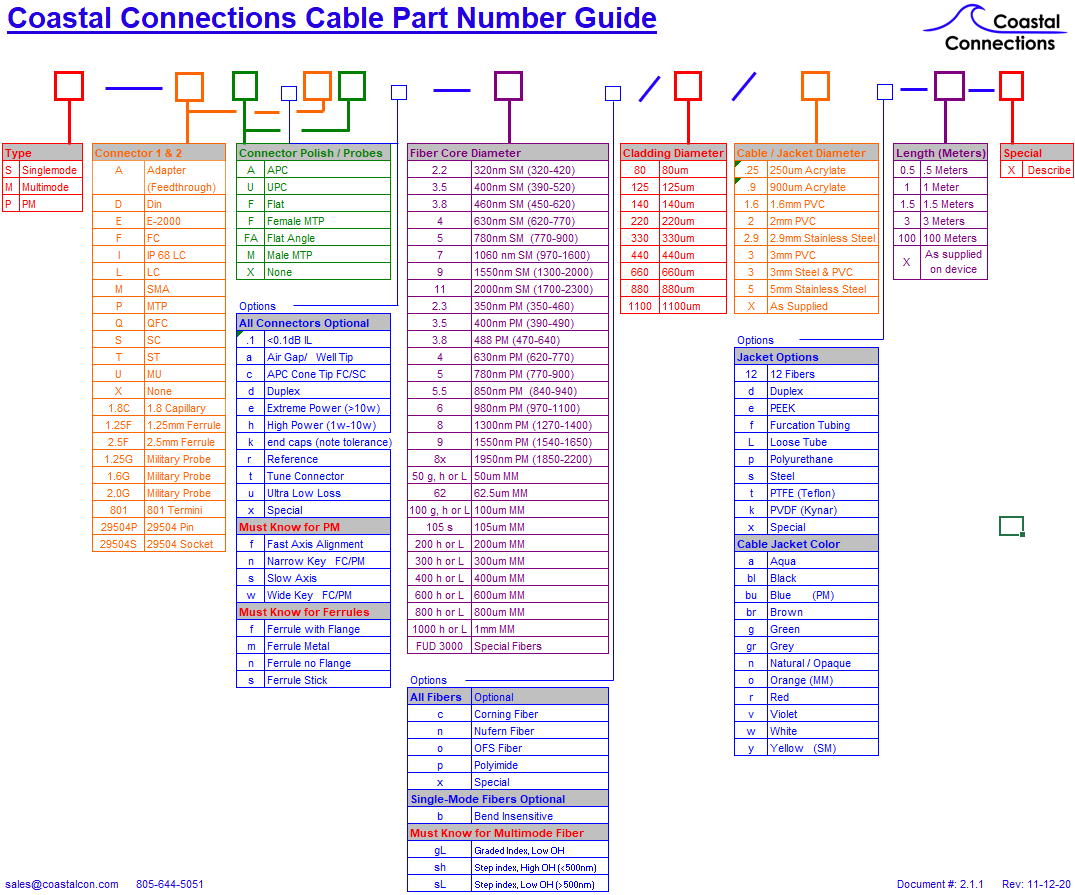FREQUENTLY ASKED QUESTIONS
Where is Coastal Connections Part Number Guide?
What causes insertion loss in a connector?
Insertion loss in connectors typically comes from misalignment of the fibers or bent fibers in the connectors from active core alignment. The misalignment comes from eccentricity of the core in the fiber, eccentricity of the hole in the ferrule and most of all the eccentricity of the fiber in the hole. Bending of the fiber typically comes from the fiber being constrained at the back of the connector while the ferrule moves back during mating.
Why is the NA of my end-cap fiber different from the NA specified by the fiber manufacturer?
End-capping a fiber will narrow the NA by around 0.003 if the manufacturer is very careful; otherwise, the process of end-capping can narrow the NA substantially. The NA fiber manufacturers list on their datasheets are typically a theoretical value or the NA of the glass preform before drawing. From what we can gather, only one of the four suppliers we use for single-mode and PM fibers has ever measured the NA of a completed fiber. And that supplier reported the NA of the fiber as the diameter of the beam divided by the distance from the source, which resulted in an NA specification two times larger than how NA is typically defined. This possibly came from there not being an industry standard for measuring the NA out of a fiber. If you know of anyone who has verified the theoretical equations for calculating NA out of a visible wavelength single-mode fiber, we’d appreciate it if you let us know.
What is a wide key and what is a narrow key on FC Connectors?
Narrow key connectors have a 2.0mm key and are used on and recommended for most FC connectors including UPC, APC, and PM connectors. They are sometimes referred to as R Type. Wide key connectors have a 2.14mm key and are required when mating an APC connector or a PM connector to a wide key connector. They are sometimes referred to as N Type. TIA FOCIS-4, which controls the widths of the keys, calls out 4 different standards but they can be grouped into wide and narrow keys.
What is the difference between a PC and a UPC polish?
A UPC (Ultra Physical Contact) is a higher quality polish than a PC (Physical Contact) polish. The UPC polish has less scratches and the higher quality as measured by the improved return loss. UPC connectors typically have 45 to 50dB return loss while PC connectors produce 25 to 30dB return loss. UPC connectors mate to PC connectors without any problem.
Why do short wavelength single-mode cables have higher insertion loss than longer wavelength cables?
The shorter the wavelength of light the smaller the mode field diameter (MFD) of the fiber. Fiber for a 400nm purple laser has a 3.5um MFD while a 1550nm laser requires a fiber with a 10.5um MFD. The 400nm fiber is 1/3 the diameter and 1/9 the area of the 1550nm fiber. If both fibers are misaligned by 1um the 1550nm fiber will have approximately 0.16dB (3.5%) loss while the 400nm fiber will have approximately 1.5dB (30%) loss.
Why do some short wavelength cables degrade over time?
Some short wavelength cables degrade over time as the fiber dopants darken, the epoxy in the connector reacts with the short wavelength light, or the laser light damages the surface of the fiber. These problems can be avoided if the cable is designed and built properly.
What is the difference between Low OH and High OH multimode fibers?
Most multimode fibers are low OH but these fibers have high insertion loss below 400nm. Below 400nm High OH fibers are recommended.
Why do active core alignment connectors have insertion loss?
In active core alignment connectors, the cores are not offset but they are at an angle to each other. This angle misalignment causes loss in the connector.

